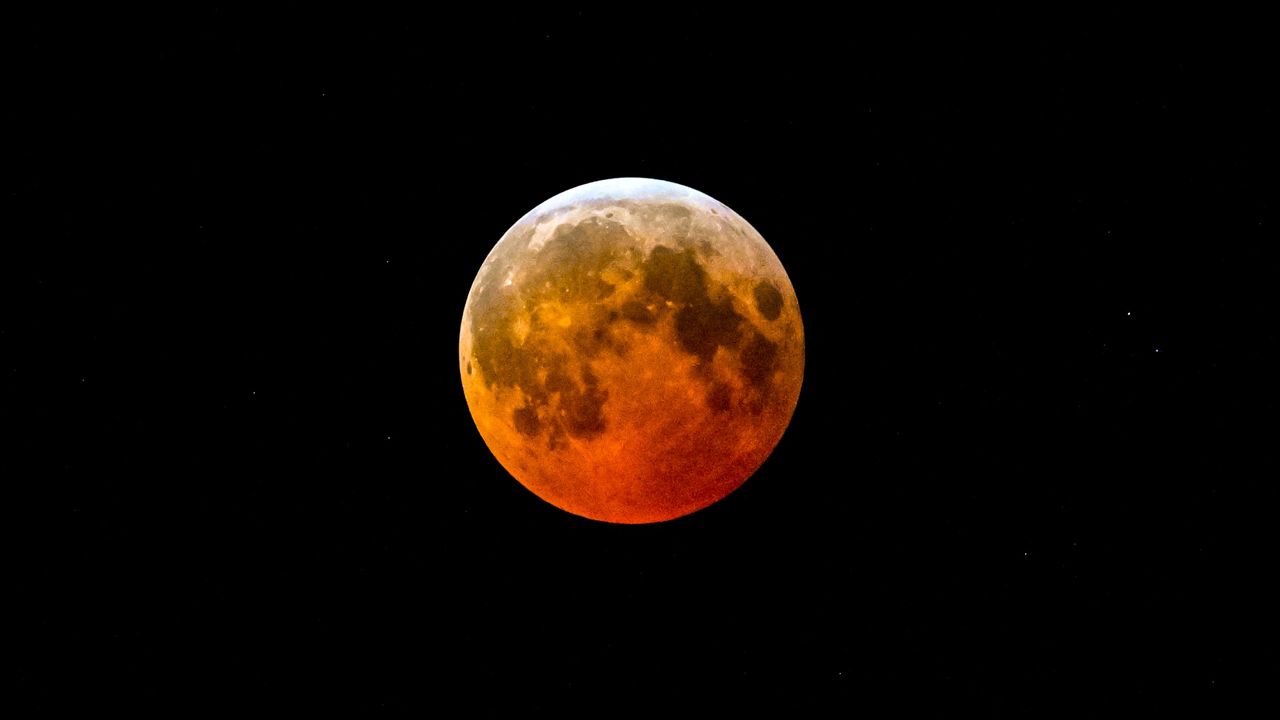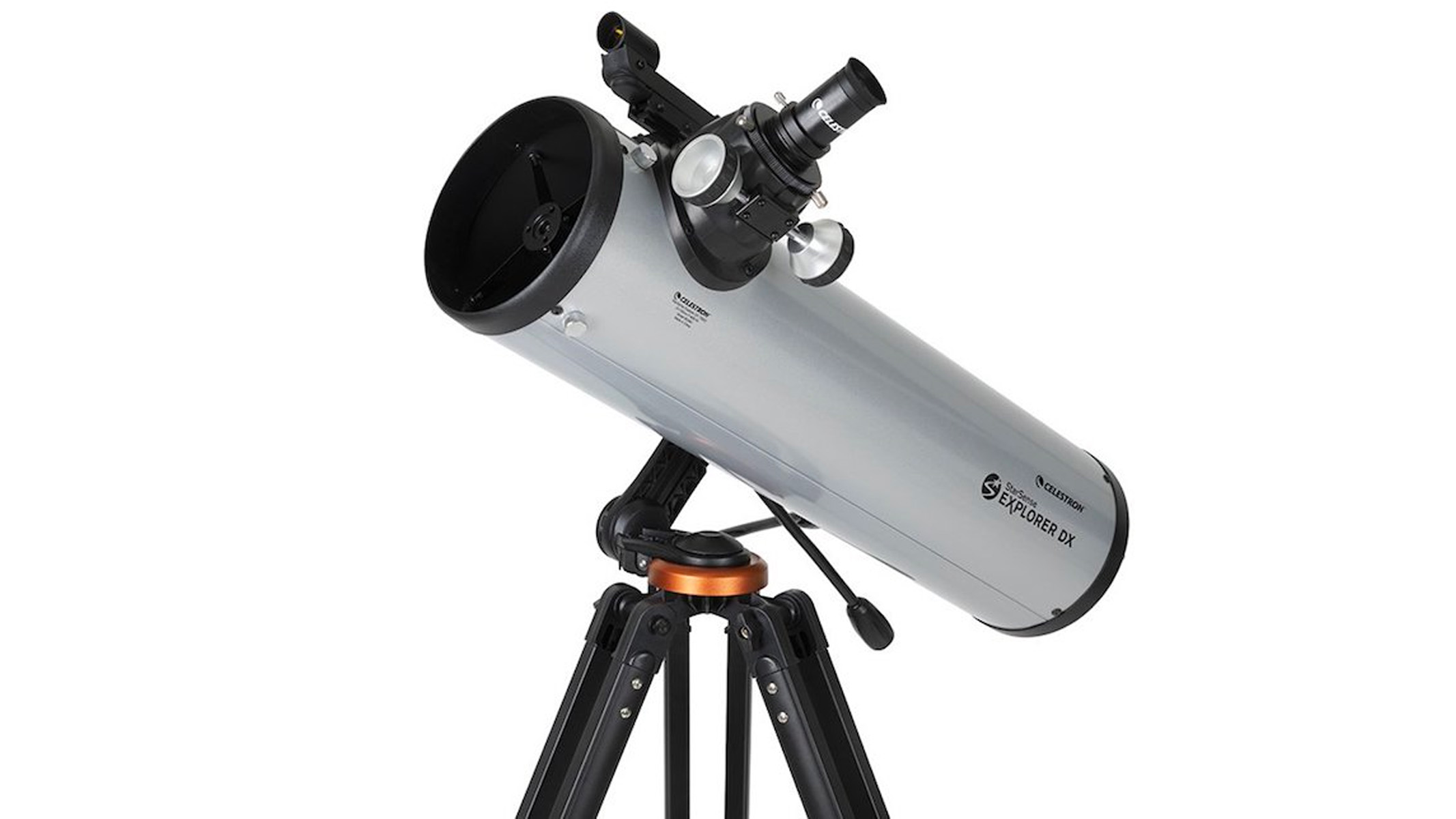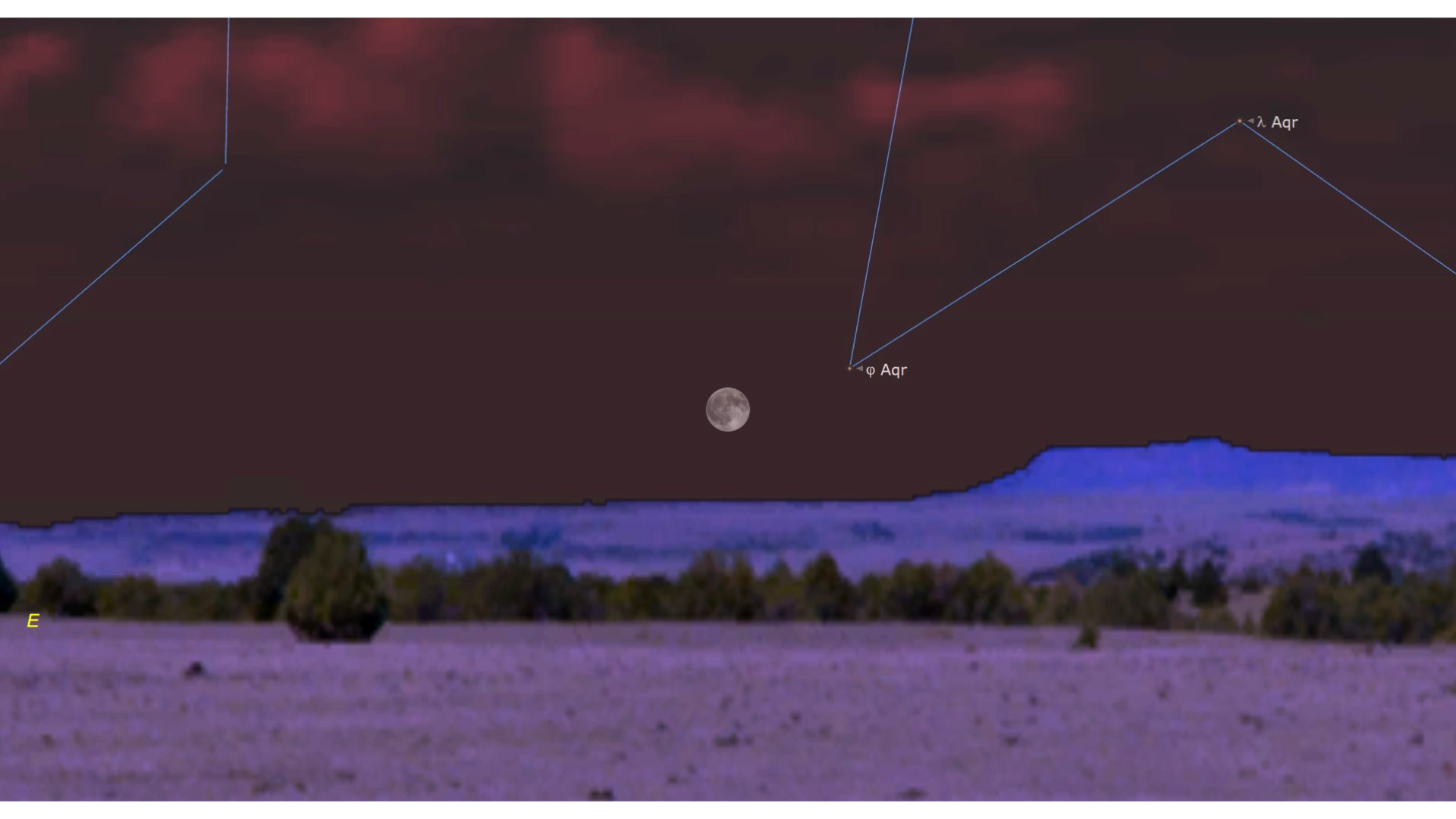
The full moon of September, called the Harvest Moon, will occur on Sept. 7. On the same night, there will also be a total lunar eclipse visible from many parts of Earth.
Full moons are reckoned when the moon is exactly on the opposite side of Earth from the sun – using the moon's celestial longitude (a projection of Earth's longitude lines on the sky) the moon has to be exactly 180 degrees from the sun. The moon's orbit is slightly tilted relative to the plane of Earth's orbit, by about 5 degrees, so usually the moon is fully illuminated by the sun at that point.
This time, the moon is lined up so that it enters Earth's shadow, creating a total lunar eclipse. The exact moment of this full moon occurs at 12:09 p.m. EDT (1809 UTC), per the U.S. Naval Observatory

Looking for a telescope for the moon? We recommend the Celestron StarSense Explorer DX 130AZ as the best for basic astronomy in our best beginner's telescope guide.
Eclipses themselves come in different varieties: a total lunar eclipse is when the moon is completely inside the darkest part of Earth's shadow, called the umbra. Partial lunar eclipses are when only part of the moon is covered (as the name implies). The earliest and latest stages of a lunar eclipse, when the moon passes through a lighter part of Earth's shadow called the penumbra, are called the penumbral phases. These are harder to see, as the penumbral shadow doesn't darken the moon that much; many observers describe it as the moon looking slightly brown.
During total lunar eclipses, the moon turns a reddish color because the light entering Earth's atmosphere is bent towards the moon. At the same time, Earth's atmosphere tends to scatter blue and green wavelengths – this is why sunsets appear reddish, and the sky is blue on a clear day. If one were standing on the moon, one would see a total solar eclipse, with Earth outlined by a reddish ring.
Unlike solar eclipses, lunar eclipses are visible from anywhere on Earth where the moon is visible. In this case the western limit for any easily visible eclipse is Iceland or the Azores; the eastern limit is western Alaska and the islands of the South Pacific such as American Samoa. At the boundaries, the eclipse either begins before the moon rises or ends after it sets.
This eclipse won't be visible at all from the continental U.S., Canada, Mexico, and almost all of South America (a portion of the penumbral eclipse is visible for about 35 minutes after moonrise in the furthest eastern states of Brazil).
To see the umbral phase of the eclipse, the furthest west one can be is in Ireland. In Dublin, for example, the moon rises at 7:57 p.m. local time on Sept. 7, and by that time the umbral phase of the eclipse has been underway for two and a half hours (it starts at 5:27 p.m.) Dubliners will see the moon rise already reddened; the lower left side of the moon will be emerging from the umbral shadow, presenting a bright crescent-like shape. At 8:00 p.m. local time the moon will reach maximum eclipse in Dublin (the true maximum is when the moon is still below the horizon). The umbral phase ends at 8:56 p.m. and the moon emerges from the penumbra at 9:55 p.m.
Further east, in London, the moon rises at 7:30 p.m. local time, and the moon is still entirely within the umbral shadow; it will appear completely red as it climbs from the horizon. The total phase ends at 7:52 p.m. and the moon emerges from the umbra at 8:56 p.m., with the eclipse ending at 9:55 p.m.
To see the start of the umbral phase of the eclipse (also known as the partial phase, because the umbra doesn't always cover the entire moon as it does in this eclipse) one has to be at least as far east as Istanbul, where moonrise is at 7:22 p.m. local time. The partial phase of the eclipse starts at 7:27 p.m., so just after that one will see a dark sliver taken out of the left side of the moon. By 8:15 p.m. the moon will look visibly red on one side and it will be entirely inside the umbra by 8:30 p.m., when the total phase of the eclipse begins. Maximum eclipse (when the moon is in the deepest part of Earth's shadow) is at 9:12 p.m. and the total phase ends at 9:52 p.m. The moon comes out of the umbra at 10:56 p.m. and the eclipse ends at 11:55 p.m.
In New Delhi, which is near the center of the area where the entire eclipse is visible, the moon rises at 6:56 p.m. local time on Sept. 7. The penumbral phase starts at 8:58 p.m., and the partial phase at 9:57 p.m. The moon enters the total phase at 11:00 p.m. as it is about 50 degrees above the southeastern horizon. Maximum eclipse is at 11:41 p.m. and the total phase ends at 12:22 a.m. Sept. 8. The partial phase ends at 1:26 a.m. and the moon leaves the penumbra at 2:25 a.m.
As one moves further east the eclipse starts while the moon is above the horizon but ends after it sets. In Melbourne, Australia, the eclipse starts at 1:28 a.m. local time Sept. 8, with the partial phase beginning at 2:27 a.m. The total phase starts at 3:30 a.m. and ends at 4:52 a.m. The partial phase ends at 5:56 a.m. and moonset is at 6:39 a.m., the penumbral phase ends after that.
In the United States, only in Alaska and Hawai'i is any of the eclipse visible. In Alaska the small town of Adak, in the Aleutian islands, will see the penumbral phase start at 6:28 a.m. local time on Sept. 7 (officially the Aleutians are on the eastern side of the International Date Line). The partial (umbral) phase starts at 7:27 a.m., and the maximum eclipse is at 8:07 a.m., when the moon will appear to have its "top" half in shadow (and turning reddish). Moonset is at 8:09 a.m. In Honolulu, Hawai'i, the penumbral phase will start at 5:28 a.m. local time on Sept. 7, but moonset is at 6:15 a.m. and the partial phase doesn't start until afterwards, at 6:27 a.m.
Visible Planets
If you can't see the eclipse, there will be other things in the sky on the night of the full moon. For observers in the continental U.S. Saturn, Jupiter, and Venus will all be visible (in that order) as the night progresses. From New York City, the full moon rises at 7:21 p.m. local time. As the moon climbs into the sky, Saturn rises at 7:54 p.m. and by 9 p.m. will appear to the left of (eastwards) and below the moon. Jupiter rises after midnight, at 1:43 a.m. Sept. 8; by 3:00 a.m. it will be about 12 degrees high in the east as the moon and Saturn move to the western half of the sky.
Venus rises in New York at 3:59 a.m. Sept. 8. Sunrise is at 6:02 a.m., so by the time the sky starts to get light at about 5:30 a.m. the planet will be about 16 degrees high in the east, with Jupiter above and to the right of it about 41 degrees high in the southeast.
In the Southern Hemisphere, Saturn also follows the moon, but appears to be on the other side (to the right rather than the left). In Buenos Aires, (where the lunar eclipse won't be visible), the moon rises at 6:45 p.m. local time and Saturn at 7:37 p.m. Jupiter rises there later than in New York, at 4:08 a.m. on Sept. 8; by that time the moon and Saturn are respectively 37 degrees and 43 degrees high in the northwest. Venus follows Jupiter at 5:43 a.m., and sunrise is at 7:03 a.m. local time. By the time of civil twilight (when the sun is 6 degrees below the horizon) Venus will be 10 degrees high in the northeast.

Constellations
The early September sky still has the summer stars, but as the night progresses those of fall become more prominent. From mid-northern latitudes, by about 9 p.m., one will see the Summer Triangle almost directly overhead. The Summer Triangle is an asterism (a group of stars) that is not a constellation; it contains Deneb, Altair, and Vega. Deneb, the tail of Cygnus the Swan, and Vega, the brightest star in Lyra the Lyre, will be the higher of the two stars with Deneb on the left as one faces south, and Vega on the right; looking straight up one hits the point directly between the two. Towards the horizon is Altair, the alpha star of Aquila the Eagle.
Altair has two fainter stars on either side of it, and if one goes from the one on the right (called Gamma Aquilae, or Tarazed) down and slightly to the right, there will be two more fainter stars that make a line that is the spine of the Eagle. Follow that and towards the horizon one can see the teapot shape of Sagittarius, though from much further north than New York or Toronto the constellation starts to get very close to the horizon and harder to see. If you see a bright reddish star in the southwest, that's Antares, the heart of Scorpius, the Scorpion; Antares is easier to spot as one goes further south; by 9 p.m. it is only 12 degrees high but in Miami or Galveston it is higher.
If one turns around to face north, (so that the moon is on your right) one will see the Big Dipper close to the horizon, with the bowl facing up. Use the two stars at the right end of the bowl, called Dubhe and Merak, and make a line upwards to Polaris, the Pole Star. Continue upwards and one ends up between the constellations Cepheus, the King, and Cassiopeia, the Queen; the latter is recognizable by its "W" shape. Below Cassiopeia is Perseus, the Hero. To the right of Cassiopeia is Andromeda, her daughter, marked by four stars that form a rough arc. At the upper end of the arc is the corner of the Great Square, which marks Pegasus, the Winged Horse.
In the Southern Hemisphere, by about 9 p.m. at the latitude of Buenos Aires or Cape Town, the Southern Cross is in the southwest, and just above it Hadar, the second-brightest star in Centaurus, the Centaur. Above that is Alpha Centauri, also called Rigil Kentaurus, the sun's closest stellar neighbor. Turning westwards one can see Antares, the heart of Scorpius, which unlike in the Northern Hemisphere appears with the claws (marked by three stars just below Antares) facing downward and is quite high – about 53 degrees – above the western horizon. Sagittarius is nearly straight overhead.
If one looks to the southeast, one can see at about a third to halfway up the sky the star Achernar, which marks the end of Eridanus, the River. By midnight one will see Canopus, the alpha star of Carina the Keel, in the southeast, almost directly below Achernar and about 11 degrees high. If one waits until after midnight it's possible to see the rest of the river — it's a long, winding constellation that ends near Orion — a winter constellation in the Northern Hemisphere. By 12:30 a.m. on Sept. 8 one can see Rigel, just rising (it will be about 5 degrees high in the East).
Moon legends
Lunar eclipses have had a lot of legendary associations – the term "Blood moon" is one of those. Ancient Greeks thought the moon was being devoured by another creature called an Empusa, a one-legged shape shifter. Greek scholars managed to figure out the periodicity of lunar eclipses, and even used eclipses to demonstrate the sphericity of Earth. But such legends persisted.
Ancient Mayans also knew of the periodicity, but they too saw the moon as being eaten – in their case by a jaguar. That said, there were other Native peoples in the Americas who saw a lunar eclipse very differently; Daniel Brown, a lecturer in astronomy at Nottingham University, wrote that the Luiseño and Hupa people would offer prayers to what they saw as an injured moon.
Seeing the lunar eclipse as a bad omen, in fact, wasn't mutually exclusive with knowing they could be predicted. Babylonians, for example, had some idea that lunar eclipses were on a predictable cycle, but they still would have a proxy take over as king while the eclipse was happening to ward off any bad effects on the kingdom.
Aside from eclipses, the September full moon is called the Harvest moon, according to the Old Farmer's Almanac, referring to when corn harvests traditionally started (it also is called the Corn Moon). European settlers adopted some Native imagery for full moon names, but they tend to be those from the Native groups that had the first contacts with the settlers – other groups would have very different associations. For the Cherokee, for example, the ninth lunation was described as the End of Fruit Moon.
In China September in the western calendar is in the Seventh lunar month called Ghost Month, and the fifteenth day – just about the time of the full moon – is the Hungry Ghost festival, one of a number of festivals held to honor ancestors.







